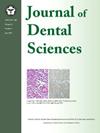Risk factors for inferior alveolar nerve injury associated with implant surgery: An observational study
IF 3.4
3区 医学
Q1 DENTISTRY, ORAL SURGERY & MEDICINE
引用次数: 0
Abstract
Background/purpose
Inferior alveolar nerve (IAN) injury is the most serious complication associated with dental implant surgery, posing difficulties in treatment and potential for permanent disabilities. This study aimed to identify patient-related risk factors for IAN injury during implant placement and to investigate sensory disturbances depending on whether the implant was removed.
Materials and methods
Twenty-eight patients with implant-related IAN injury were included. To determine risk factors, patient demographics and radiographic images were analyzed. Sensory functions were evaluated and compared based on whether the implant was removed.
Results
IAN injury occurred more frequently in women (60.7%), with a mean age of 62.9 years. The distance from the alveolar crest to the IAN was 9.8 ± 3.0 mm, with 40.9% patients having a residual alveolar bone of 10 mm or more. The mean bone density was measured at 586.2 ± 392.5 HU, which is below the normal range for the mandible. Notably, 31.8% of the patients were found to have D4 bone. Compared to patients who did not have implants removed, those who did showed better sensory function, except pressure perception, although these differences were not statistically significant.
Conclusion
Older women with lower bone density were at an increased risk of IAN injury, and IAN injury occurred even in cases with sufficient alveolar ridge. The removal of implants related to the injury alone does not markedly influence the extent of sensory disturbances during follow-up period, suggesting that other aspects such as the timing of removal and severity of injury could be crucial.
种植手术相关下牙槽神经损伤的危险因素:一项观察性研究。
背景/目的:下牙槽神经(IAN)损伤是牙科种植手术中最严重的并发症,不仅给治疗带来困难,还可能导致永久性残疾。本研究旨在确定种植体植入过程中导致下牙槽神经损伤的患者相关风险因素,并根据种植体是否被移除调查感觉障碍:研究纳入了 28 名与植入物相关的 IAN 损伤患者。为确定风险因素,对患者的人口统计学特征和放射影像进行了分析。根据是否移除植入物对患者的感觉功能进行评估和比较:IAN损伤多发于女性(60.7%),平均年龄为62.9岁。从牙槽嵴到 IAN 的距离为 9.8 ± 3.0 mm,40.9% 的患者牙槽骨残余在 10 mm 或以上。平均骨密度测量值为 586.2 ± 392.5 HU,低于下颌骨的正常范围。值得注意的是,31.8% 的患者的骨密度为 D4。与未移除植入物的患者相比,移除植入物的患者显示出更好的感觉功能,但压力感觉除外,尽管这些差异在统计学上并不显著:结论:骨密度较低的老年妇女发生 IAN 损伤的风险较高,即使牙槽嵴充足的病例也会发生 IAN 损伤。在随访期间,仅移除与损伤相关的种植体并不会明显影响感觉障碍的程度,这表明其他方面,如移除的时机和损伤的严重程度可能至关重要。
本文章由计算机程序翻译,如有差异,请以英文原文为准。
求助全文
约1分钟内获得全文
求助全文
来源期刊

Journal of Dental Sciences
医学-牙科与口腔外科
CiteScore
5.10
自引率
14.30%
发文量
348
审稿时长
6 days
期刊介绍:
he Journal of Dental Sciences (JDS), published quarterly, is the official and open access publication of the Association for Dental Sciences of the Republic of China (ADS-ROC). The precedent journal of the JDS is the Chinese Dental Journal (CDJ) which had already been covered by MEDLINE in 1988. As the CDJ continued to prove its importance in the region, the ADS-ROC decided to move to the international community by publishing an English journal. Hence, the birth of the JDS in 2006. The JDS is indexed in the SCI Expanded since 2008. It is also indexed in Scopus, and EMCare, ScienceDirect, SIIC Data Bases.
The topics covered by the JDS include all fields of basic and clinical dentistry. Some manuscripts focusing on the study of certain endemic diseases such as dental caries and periodontal diseases in particular regions of any country as well as oral pre-cancers, oral cancers, and oral submucous fibrosis related to betel nut chewing habit are also considered for publication. Besides, the JDS also publishes articles about the efficacy of a new treatment modality on oral verrucous hyperplasia or early oral squamous cell carcinoma.
 求助内容:
求助内容: 应助结果提醒方式:
应助结果提醒方式:


